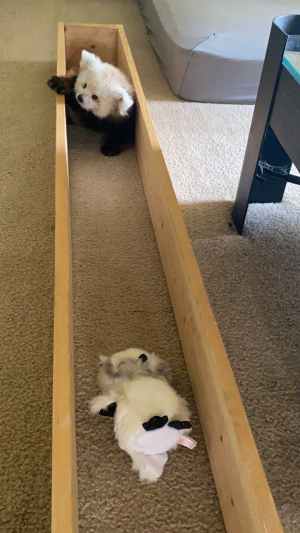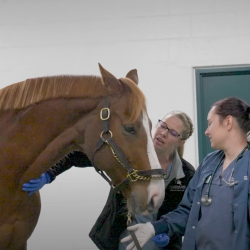Featuring Dr. Audrey Siegrist, veterinarian at Potawatomi Zoo; Dr. Robert Sanders, associate professor of Small Animal Clinical Sciences at the MSU Veterinary Medical Center
Raya is a 1.5-year-old red panda who lives at Potawatomi Zoo in South Bend, Indiana. In the early months of her life, Raya had to be diligently cared for by the Zoo’s medical team and resident veterinarian, Dr. Audrey Siegrist, due to numerous health issues. The MSU Veterinary Medical Center has also played a role in the medical care of Raya.

Early life
As a newborn, Raya had to be hand-raised due to aspiration pneumonia, a common cause of mortality in red panda neonates.
Raya spent time in an incubator and was fed via syringe, as her strength to nurse was impaired from the pulmonary infection. The Zoo medical team kept her on 24-hour care. She experienced two additional bouts of aspiration pneumonia over the following weeks.
“Red pandas are known to be challenging to hand-rear, but Raya made it through,” says Siegrist.
At several months of age, Raya developed splay leg (or “swimmer syndrome”). The Zoo medical team conducted multiple daily physical therapy sessions with her in a custom-made exercise track to improve her hind leg muscles. Her legs were also outfitted with hobbles during the daytime to help them adjust. Raya’s gait significantly improved with time.
After several months, Raya was healthy enough to be reunited with her dam and littermate.
During treatment for suspected toxoplasmosis (Raya’s dam, who shared her enclosure, had tested positive for toxoplasmosis), the Potawatomi Zoo team discovered a grade 3/6 systolic heart murmur, with suspected right atrial enlargement. She did not test positive for toxoplasmosis.
An electrocardiogram was performed at the zoo, and the results seemed normal. Bloodwork, including a heartworm test, was normal. Additional diagnostics were needed to identify potential congenital cardiac disease or malformation.
She was brought for further screening to the MSU Veterinary Medical Center.
Presentation at MSU
Raya was brought to MSU for a full cardiac workup at the Hospital’s Cardiology Service. Upon presentation, she was bright, alert, and responsive.

Upon performing an echocardiogram, Dr. Robert Sanders, associate professor of Small Animal Clinical Services, found mild mitral valve regurgitation and trace tricuspid valve regurgitation, with possible abnormal chordae tendineae positioning of the mitral valve, and possible slight dilation of the left ventricular wall.
The echocardiogram found no ventricular septal defect nor patent ductus arteriosus. There was no obvious abnormality with the right atrium, as was suggested on survey radiographs. There was also no evidence of heartworm disease.
Treatment and Recovery
Raya’s medical team concocted a plan to address potential health issues that Raya might face. She was prescribed ponazuril once monthly, since her enclosure mate had a high toxoplasmosis titer. Her weight would be rechecked weekly, and she would return to MSU in six months for another cardio exam (sooner if problems presented).
Raya and her team made the two-and-a-half-hour journey to East Lansing six months later for her next cardio exam, which revealed that her heart was stable. She no longer needed any medication, and at her home in Potawatomi Zoo, has been playful and active, with no signs of problems. It was recommended that Raya be examined again in another nine months.



